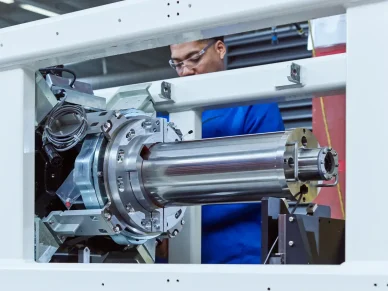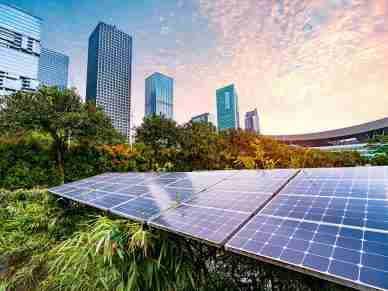
, the power sector must implement strategies to significantly reduce its carbon footprint.
This guide explores various approaches, technologies, and policies to help the power sector transition to a low-carbon future while maintaining reliability.
Understanding Greenhouse Gas Emissions in the Power Sector
Methane (CH₄), nitrous oxide (N2O), and carbon dioxide (CO₂) are the main greenhouse gases (GHGs) released by the electricity industry. The main cause of these emissions is burning fossil fuels like coal, oil, and natural gas to produce power.
According to the U.S. Energy Information Administration (EIA), burning fossil fuels to generate energy accounted for 73% of the total greenhouse gas emissions in 2021. Moreover, its total share in the anthropogenic CO2 emissions in the US was 92%.
CO₂ is the most prevalent, but CH₄ and N₂O, although emitted in smaller quantities, have a much higher global warming potential. A comprehensive approach targeting all these gases is essential to effectively reduce GHG emissions.
Transitioning to Renewable Energy
One of the most effective ways to reduce GHG emissions is to transition from fossil fuel-based power generation to renewable energy sources. When in use, renewable energy sources, including solar, wind, hydroelectricity, and geothermal energy, emit little to no greenhouse gases.
Solar Energy
Solar power captures energy from the sun using concentrated solar power systems or photovoltaic cells. It provides a plentiful and clean energy source that may be installed on a variety of surfaces, including big solar farms and residential rooftops. Because of advancements in solar technology and falling costs, solar energy is now a competitive and feasible option.
One of the biggest examples of using this renewable energy is solar panels, which are quickly being adopted across the US. As noted by Pew Research, residential solar panel installations skyrocketed from 2.9 to 3.9 gigawatts in 2021. Moreover, the second quarter of 2022 was the fifth consecutive year of increase in solar power adoption. One key attraction for the quick adoption could be the government’s 30% solar tax credit.
Wind Energy
Wind turbines transform wind currents into electrical power, producing wind energy. Both onshore and offshore wind turbines may produce significant amounts of sustainable energy. Innovations in turbine installation and design have lowered prices and increased efficiency, making wind power a major component of the mix of renewable energy sources.
Hydroelectric Power
Hydropower produces energy by using the movement of water. It is among the most well-known and traditional forms of renewable energy. Small-scale and run-of-the-river hydroelectric systems provide more sustainable solutions with less ecological disturbance than large-scale hydroelectric projects, which can substantially negatively affect the ecosystem.
Implementing Carbon Capture and Storage
A technique called carbon capture and storage (CCS) is intended to absorb CO2 emissions from industrial and power plant sources. CCS can greatly aid in reducing emissions from fossil fuel-based power plants.
Several carbon capture technologies are currently being developed and deployed, including post-combustion, pre-combustion, and oxyfuel combustion capture. Each technology has advantages and challenges, and the choice of technology depends on the power plant’s specific characteristics and the available infrastructure.
According to Atoco, the power sector is a heavy-emitting and hard-to-decarbonize industry. It can use carbon capture as a scalable and efficient solution to reduce its carbon footprint. Moreover, these companies can even store and use the captured carbon dioxide for other applications like enhanced oil recovery, synthetic fuels, carbon mineralization, etc.
Captured CO2 can be kept in unmineable coal seams, deep saline aquifers, or depleted oil and gas fields. For CCS to be successful, long-term security and stability of CO2 storage sites must be guaranteed. Monitoring and verification systems are essential to detect and prevent leaks.
Enhancing Energy Efficiency
Improving energy efficiency within the power sector can reduce GHG emissions. Demand-side management, operational enhancements, and technology breakthroughs can all lead to increases in efficiency.
Technological Advancements
Investing in modern, high-efficiency power plants can significantly reduce emissions. Compared to conventional facilities, integrated gasification combined cycle (IGCC) and combined cycle gas turbines (CCGT) provide fewer emissions and greater efficiency. Additionally, upgrading existing plants with advanced control systems and more efficient equipment can further reduce emissions.
CCGT plants require the assistance of other systems that can help predict nitrogen oxides (NOx) emissions. A ScienceDirect study discovered that combined-cycle power plants can still harm the local people and infrastructure. Accurate NOx emission estimation is crucial for reducing the environmental effects of current facilities and building incinerators.
Operational Improvements
Power plant operation optimization may lower emissions and increase efficiency. This includes implementing better maintenance practices, optimizing fuel use, and using data analytics to predict and mitigate inefficiencies. Maintaining ideal operating conditions can also be aided by sophisticated monitoring and control systems.
Demand-Side Management
Reducing energy consumption through demand-side management (DSM) programs can lower the overall need for electricity generation, thus reducing emissions. DSM strategies include energy efficiency programs, demand response initiatives, and promoting energy-saving technologies and behaviors among consumers.
Leveraging Smart Grid Technologies
Smart grid technologies can enhance electricity generation and distribution efficiency, reliability, and sustainability. By integrating advanced communication, control, and automation technologies, smart grids enable more efficient management of electricity flows.
Real-Time Monitoring and Control
Smart grids provide real-time data on electricity consumption, generation, and distribution, allowing for better decision-making and more efficient resource use. This can lessen losses, improve supply and demand equilibrium, and enhance grid efficiency.
Integration of Renewable Energy
Because smart grids are more responsive and flexible, they make it easier to integrate fluctuating renewable energy sources. Advanced forecasting and energy storage systems can help manage the intermittency of solar and wind power, ensuring a stable and reliable supply.
Demand Response Programs
Demand response programs are made possible by smart grids, which motivate customers to modify their power use during peak hours in response to rewards. In addition to lowering emissions and preventing the need for more power-generating capacity, this can assist in reducing peak demand.
Frequently Asked Questions
In what ways does the energy sector release greenhouse gases?
The primary source of greenhouse gas emissions from the energy sector is burning fossil fuels, including coal, oil, and natural gas. Not insignificant volumes of CO2 and other greenhouse gases are emitted into the environment during the burning of these fuels to produce power.
How is energy produced using fossil fuels?
The fuels are sent to processing facilities, where they are processed into products that may be used, such as diesel or gasoline. These refined fuels are used in boilers or turbines to produce heat in power plants. Steam generated by this heat powers turbines connected to generators to produce energy.
Which industries produce the most greenhouse gases?
Transportation, industrial processes, and burning fossil fuels for heat and power are the main producers of greenhouse gases. Agriculture, mainly methane-producing rice fields and animal emissions, also makes significant contributions.
In summary, lowering greenhouse gas emissions from the electricity industry is essential to halting global warming and building a sustainable future. Adopting a comprehensive strategy that encompasses switching to renewable energy, improving energy efficiency, and creating frameworks for supporting policies is imperative. By embracing these strategies and fostering international cooperation, the power sector can play a pivotal role in reducing global GHG emissions.
















Leave a Reply